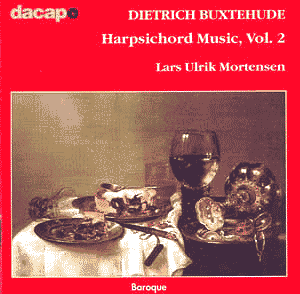Dietrich BUXTEHUDE
(1637-1707)
Harpsichord Music Vol. II
Aria: More Palatino in C Major [15.59]
Suite in G minor [7.54]
Fuga in C Major [2.50]
"Courant Zimble" in A minor [7.27]
Canzonetta in G Major [2.10]
Suite in E minor [10.08]
Canzona in G Major [4.02]
Nun lob, mein Seel, den Herren in G Major [2.12]
 Lars Ulrik Mortensen,
harpsichord Lars Ulrik Mortensen,
harpsichord
Rec: September 1998
 DA CAPO 8.224117 [52.42] DA CAPO 8.224117 [52.42] |
 |
| Crotchet
AmazonUK
AmazonUS
Amazon
recommendations |
Da Capo has, so far, released 3 CDs of Buxtehude's harpsichord works, all
performed excellently by Lars Ulrik Mortensen. This is the second volume
of this series.
As in the first volume of the series, the works selected for this disc show
the full ranges of Buxtehude's keyboard styles and forms. The first work
is one of Buxtehude's three arias - he had a penchant for works with variations.
What he called an aria, for keyboard, was a piece containing an initial
exposition and several variations. The Aria: More Palatino in C Major is
a vast work; at almost 16 minutes. It is one of his longest keyboard works.
It contains 12 variations, and begins with a lively exposition of the theme.
The variations vary in style and ornamentation - the basic melody is present
in all of them, as Buxtehude changes the forms, rhythm, and elaborations
of the theme. This is an engaging work, which also provides the performer
with an opportunity to show his talent.
The Suite in G minor, like Buxtehude's other suites, is in four movements
that alternate slow-fast-slow-fast, although the fast movements are not very
rapid. The allemande, which presents the thematic material for the suite,
is a measured, moving theme that explores the limits of the meantone tuning
of the instrument. The other movements follow the discourse of this thematic
structure: a courante that is bouncy, but not very fast, a sarabande that
is melancholic, and a gigue that recalls some of François Couperin's
dance movements, however with less ornamentation.
The Fuga in C Major, written originally for organ, is a lively, energetic
fugue, which contains the longest subject that Buxtehude used for any of
his fugues: a vast, six measure theme. With a theme this long, it is more
difficult to hear the elaboration of the fugue, but Buxtehude constructed
here a delightful work that ends with a brisk toccata-like conclusion.
Another variation work comes next: the Courant Zimble in A minor, a series
of eight variations on a courante. The dance-like nature of the form is much
more apparent here than in some of Buxtehude's other pieces. This is a
noble-sounding subject, which, in its first four variations, is embellished
and ornamented in a variety of manners, as each variation becomes increasingly
complex, with both the right and left hand parts developing. Sounding more
like a chaconne, the four variations themselves do not stray from the original
exposition, but rather seem to add on additional textures. The fifth variation
changes the rhythmic structure slightly, and the theme is presented differently,
marking the second "section" of the work. The final three variations explore
further rhythmic and melodic changes, and the overall feeling of this work
is one of grace and elegance.
The Suite in E minor, like the first suite, is in four movements, and, it
is also in a minor key, giving the usual melancholy feeling often indicative
of such keys. E minor is a particularly sad key, and Buxtehude uses chromatic
notes, which sound ever so slightly "out of tune" to add a great deal of
tension to the allemande. The courante is a spectacular piece, ending with
a series of extensive arpeggios. The sarabande is slow and minimal, using
very few notes in the right hand part, and even fewer in the left hand. This
sparse movement is one of the most touching of this entire recording. Finally,
the suite ends with a gigue that is as lively and energetic as the courante.
Like volume one in this series, this is an excellent recording. One cannot
help but be amazed, yet again, at the variety of music Buxtehude wrote for
the harpsichord, from moving suites to complex and fulfilling variations.
A must-have recording, for anyone who likes harpsichord music.
Kirk McElhearn

